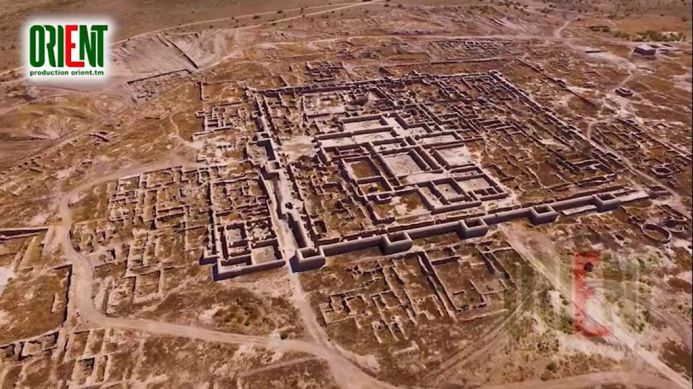Why great civilisations perish?
15.04.2020 | 10:04 |In April issue of one of the most popular scientific magazines of France «La Recherche» ("Search") an article devoted to archaeological excavations in Turkmenistan was published. Its author - Doctor Julio Bendezu-Sarmiento, French archaeologist and the bio-anthropologist, Director of the French-Turkmen archaeological expedition (МАFTUR). Nowadays he conducts researches in the laboratory of the ecological anthropology in the Parisian Musée de l'Homme ( Museum of Man).
Some years ago the magazine «La Recherche» founded the special award for encouragement of French-speaking scientific works in the field of fundamental or applied researches. The award’s purpose consists in encouraging scientific personnel and to popularise their results among the wide public through the magazine.

This award is annually awarded to eleven groups, including in the field of archaeology. The team of Doctor Bendezu-Sarmiento which has already worked for many years successfully in Turkmenistan also became owner of this award.
Offering the readers a material of the French scientist, ORIENT underlines that the term «The civilization of Oxus» is accepted only in France. According to the majority of experts of Russia, the USA, Turkmenistan and other countries, more exact is the term entered into scientific circulation by well-known archaeologist Victor Sarianidi, - «Bactria–Margiana Archaeological Complex or in short BMAC that also is deciphered as «Bactria–Margiana Archaeological culture».
The matter is that Oxus - the antique name of the Amu Darya which proceeds far enough from ancient delta of the Murgab where Margiana - the most well investigated centre of this civilisation settled down. And only the eastern part of this ancient state called nowadays as Bactria, was in the river basin of Oxus-Amu Darya.
Today the ORIENT publishes (in fact, with small reductions) translation the article of Doctor Bendezu-Sarmiento into Russian.
* * *
MYSTERIOUS DISAPPEARANCE OF the OXUS CIVILIZATION
3500 years ago the Oxus civilisation in Central Asia fell into decay. Nobody knows why it happened. But recent excavation and the analysis of new finds should help to throw light on such sudden fall.

This little-known civilisation existed more than six centuries, at the end of the 3rd – early 2nd millennium B.C., in the heart of Central Asia, between the plateau of Iran, the Caspian sea and mountain ranges of the Hindu Kush in the north of Afghanistan. It definitively disappeared about 1500 B.C., having left few traces. But now the Oxus civilisation is represented as one of the most important in the history of the Ancient East.
To science it became known only seventy years ago. The first discoveries were made by the Soviet archaeologists in the 1950-ties. In Mesopotamia sources the existence of such civilisation to the east from the plateau of Iran was mentioned, but we had no idea of its geographical extent and features of its occurrence and development. First, during archaeological excavations settlements and atypical objects were unearthed, some of which today cannot be explained.
Since the 1970-ties, discovery of different centres of this civilisation followed one after another across all Central Asia. At this particular time the imperial city of Gonurdepe which, undoubtedly, was the capital of the Oxus civilisation was found out. The city was in the north of the territory, in area which then was called Margiana.
In the 1980-ties in the works published by the Soviet scientists about such monuments as Gonur-depe, Altyn-depe (Turkmenistan), Jarkutan (Uzbekistan) and Dashly (Afghanistan), the existence of an independent and autonomous civilisation in Central Asia was underlined. Its pioneer Victor Sarianidi named the unearthed culture the Bactria-Margiana archaeological complex which then became more known as Oxus civilization.
This sedentary community of farmers and cattlemen initially developed in settlements from the mud houses constructed on extensive plains and fertile deltas of the great rivers of Central Asia, including the Amu Darya. People bred there horned cattle, sheep, goats, horses and camels, and also practised artificial irrigation of the big areas under crops.
In scientific circles at once there arose a question on the origin of this civilisation, and in more general plan - a question on settlement of Central Asia in the ancient time. Though initially it was considered that the mass arrival of population from the north could destabilise or destroy the existing culture, the recent research of geneticists has put this hypothesis under suspicion: during all period of the apogee inhabitants of the Oxus pool experienced great genetic mixture, without weakening thus the local political power.
In other words, numerous resettlements, migrations only enriched this civilisation. And though its local roots are quite visible, the influence of the next regions, including the Indus civilisation in the south, the steppe world in the north, Mesopotamia and Elam in the west is also quite obvious.

All of them traded in precious materials and products, and also exchanged ideas and, probably, religious concepts which played an important role in development of the Oxus civilisation. So important is that its population, unlike the more known neighbours who did not yet knowing writing, created objects with difficult architecture, and also made production of high technological level. It became clear that mountains and deserts which were considered till now as obstacles, at that time became more and more surmountable. Through them caravan routes, but for delivery not silks, and, possibly, minerals and ore were laid.
Life of that time is represented rather stable in homogeneous, quiet and peace social and economic, political and a religious context. Only one object, Dashly-depe in Afghanistan, testifies to conduction of some military operations. But the big wars as we believe them, did not take place yet there exactly.
In relations between cities there should be conflicts, but as a whole under the direction of one or several governors there was a wide political unity - mainly, between Gonur-depe and Jarkutan in the south of modern Uzbekistan. Actually, the whole network of exchanges prospered all over the continent from the Levant to the valley of the Indus.
However, at the end of the Bronze age (about 1700 B.C.) the Oxus civilisation started to fall into decay. All the southern part of Central Asia became a zone of new cultural contacts with arrival and movement of groups of the population from other lands.
On the one hand, an increasing value during this period was gained by the rest of the populations occurring from the northern zone of Central Asia - basically from Kazakhstan and Southern Siberia. These are carriers of the so-called Andronovo cultures.

On the other hand, in the Oxus civilisation there were new cultures. They combined various lines of the Andronovo and Oxus civilisations: it Vakhsh and Bishkent cultures in the southwest of Tajikistan.
These two mobile cattle breeding cultures of the late Bronze age (1700-1500 BC) are known, mainly, thanks to the discovery of their burials.
During this period there was a decline in all spheres of life of society: archaeologists mark abandonment or reduction of sizes of settlements, change and impoverishment of material culture, architecture became easier, inter-regional communications were slowed down. The majority of metal subjects disappeared from use, quality of pottery worsened, funeral ceremonies also changed.
During excavation we have understood that exactly burial places which can be considered as a harbinger of onset of Zoroastrianism, monotheistic religion entering in the region in the first millennium B.C. then appeared.
What are reasons of such decline?
Originally it was considered that it coincides with arrival of migrants from northern regions. The thought on the aggressive foreigners in large quantities getting into the territory of the Oxus civilisation, has had a wide development in works of some Soviet archaeologists. Considered as nomads and soldiers or even marked as barbarians, these people stood at the root of destruction of cities and entire Oxus civilisation.

Among other hypotheses which have been put forward in attempt to explain these transformations, some scientists assume infringement of balance of the social and economic system, caused by strengthening of dryness of the climate and, as consequence, decrease in agricultural potential. After enough damp environmental conditions the drought began approximately in 2000-1800 BC, gradually reducing the drain of rivers and accelerating approach of sand of the desert Kara Kum …
But anyway there is not enough data for such conclusions.
The strong civilisation is quite capable to sustain pressure of nature but if the political power was already weakened, then the climate change can appear fatal. In itself dryness does not explain this decline, but it could play well a negative role. The commercial exchange, undoubtedly, promoted the rise of the Oxus civilisation - in particular, intensive trade with all the Near East.

It concerns raw materials, including ores, first of all the tin used for manufacture of products from bronze, and also a lapis-lazuli. Faults in work of these markets, connected with trade in tin - one more plausible reason of decline of the Oxus civilisation.
A considerable growth of the population also could become the reason of decline. If concentration of the population in the city centres had reached critical level, it could destroy developed public structures. The hypothesis about demographic accident is often connected with occurrence of environmental problems after aridization of soil or disappearance of the rivers as it was in Margiana that in turn caused social decomposition or even extinction of part of the population.
At last, the Oxus civilisation could disappear as a result of internal socio-political upheaval: conflicts between the elite, class struggle, economic failure and other public upheavals - a hypothesis which also belongs to the number of "classical" explanations of decline of civilisations.
After such inexhaustible list of the reasons can we draw a conclusion?
For the present we cannot, as the final period of life of the Oxus civilisation remains till now little-known.

In spite of the fact that for last forty years many excavations had been carried out, a great number of data which should be processed, and have not been found out yet, is far beyond possibilities of those few groups of researchers which work today over this theme.
The estimation of knowledge is necessary for the best characteristic of this stage, and also for understanding of evolutionary processes in the Oxus civilisation before its definitive replacement by a complex of cultures of the early Iron Age. Traces of this transition can be found in several monuments. There our teams, to be exact, in two places now work: it is Jarkutan in the south of Uzbekistan and Ulug-depe in Turkmenistan.
With means of our versatile team from the French-Turkmen archaeological mission we since 2001 have carried out new excavations at Ulug-depe where stratigraphic layers of transition from the Bronze Age to the Iron Age are well presented. Meanwhile, the analysis of ancient DNA from human remains already gives the information on migrations, and isotope structure of the markers which have been found out on teeth, allows learning a diet of people and sometimes where he lived - in mountains or on plains.
Thus, in the nearest years we should learn more about nomad or sedentary way of life of these ancient people, about their geographical and dietary adaptation.

It is easy to imagine that all considered factors could play a role in the decline of this civilisation which was cruel enough. But we hope that present excavation and analyses will allow to define, how much important was this or that event and whether it coincided with fatal circumstances which had led to disappearance of this still little-known, but such bright civilisation.
Translation from French
The origin of the article can be downloaded here.











